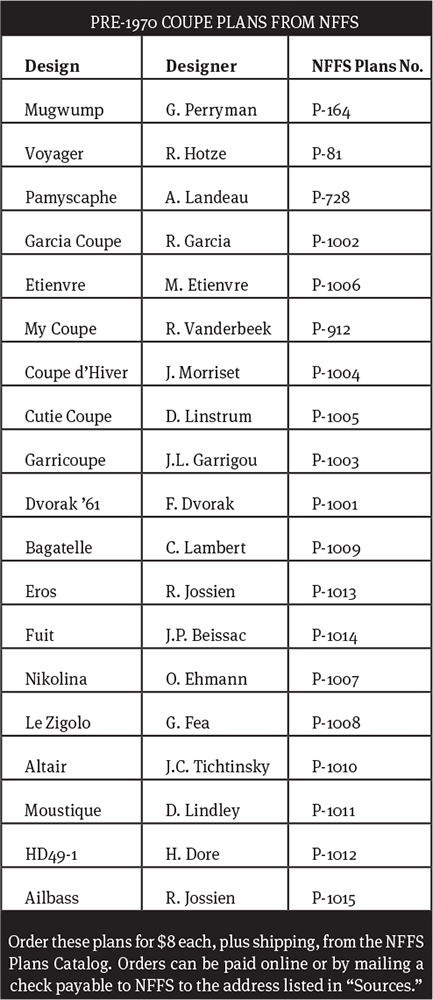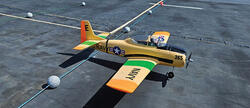Free Flight Sport By Don DeLoach | [email protected] As seen in the April 2023 issue of Model Aviation. IN THE LATE 1930S, French modelers realized that a smaller, more compact Rubber class was needed for compact flying sites in France. They developed a simple Rubber model formula: 100-grams minimum airframe weight; 10-grams maximum rubber weight; 20 square cm of fuselage cross-sectional area; and models must rise-off-ground (ROG). They dubbed the event Coupe d’Hiver, or Winter Cup. The first Coupe competition was held in France in 1945 and was an immediate success. Coupe d’Hiver’s popularity surged through the 1950s and ’60s, and in the 1970s, FAI adopted it as an international competition class with the designation of F1G. Coupes were the first Duration Rubber models intended for smaller flying fields and shorter flights. The relatively small motors meant that the models had propeller runs of a minute or less and only flew approximately 2 minutes, which was long enough to have fun in the winter season on the smaller flying sites in continental Europe.

Modern Coupes
For the first three decades of its existence, Coupe d’Hiver was a very simple event. Wing areas were approximately 150 sq. in. and models flew nearly 2 minutes using a freewheeling or folding propeller. Around the early- to mid-1970s, wing aspect ratios increased and the still-air performance of Coupes went up. About this time, some innovative modelers also began to incorporate variable-incidence tails (VIT), which further increased performance. By the 1990s, the best Coupes had VIT, auto rudder, a variable-incidence wing, and delayed propeller release—just like a modern F1B model. These modern F1Gs are made mostly of carbon fiber and Kevlar and are capable of astounding (4-plus-minute) still-air performance.


Coupe d’Hiver Kits From Hummingbird
Bernard Guest’s Hummingbird Model Products has emerged in recent years as one of the finest suppliers of Free Flight (FF) kits and accessories. Bernard is offering three Golden Age (pre-1970s) Coupe d’Hiver kits, all of which feature his expertly drawn CAD plans and precision laser-cutting on top-quality balsa. The Coupe plans and kits offered by Hummingbird are three of the best: Etienvre’s 1954 Vintage Coupe, Eleya’s 1963 Coupe, and the 1960s French Coupe by Roger Taylor (traced for Hummingbird by Archie Adamisin). Plans are $10 and kits are $55; both can be ordered online. Hummingbird’s contact information is listed in "Sources." The company also offers models, parts, and supplies for modern F1G Coupes from top builders such as Evgeny Gorban and Stepan Stefanchuk.Golden Age Coupes at the Nats
The 2023 Outdoor FF Nats will feature a special event for Golden Age Coupe d’Hiver aircraft. The event will be flown in Muncie, Indiana, at the International Aeromodeling Center on July 17-23. A detailed schedule will be available soon on the National Free Flight Society (NFFS) website, listed in "Sources." Dozens of 1940s to 1960s designs are available from the NFFS Plans Service for scratch building, and at least three kits are available. Bob Hanford will be flying the original model he flew in the 1970 Nats as a 17-year-old AMA Senior contestant.
Golden Age Coupe—Official Rules for the Outdoor FF Nats 2023 Event
Eligibility: Any documented Coupe d’Hiver design that was designed before January 1, 1970. There are a few Coupes published in the early 1970s where the magazine text says that they were designed before January 1, 1970. In such cases, the designs are legal for this event. Contestants are responsible for proving eligibility.- Models must be built to plans. Burden of proof is on the entrant to bring his or her building plans/construction article in case of questions.
- No variable geometry flight surfaces, even if shown on the original plans.
- Original airfoils and spar placement must be used. Additional spar(s) may be added. No D-boxes or geodetic ribs unless used on the original.
- Plans wood dimensions may be increased but not reduced.
- Carbon fiber, Kevlar, and fiberglass may be used sparingly to increase strength/durability in key areas. Don’t overdo it. It is the contest director’s discretion on this.
- Rolled fuselage tubes are permitted only if used on the original design.
- Carbon-fiber/Kevlar/aluminum motor tubes and tailbooms are not permitted.
- Any covering may be used.
- Takeoff gear may be omitted.
- Propeller must not exceed the plans diameter.
- Propeller type must be the same as the original (one-blade folder, two-blade folder, or freewheeler). Any type of propeller hub may be used on folders, except no delayed- or instant-release hubs.
- Minimum 70 grams empty airframe weight.
- Maximum 10 grams lubricated motor weight.
- No rounds. No ROG required. Three flight total; 120-second maxes. Fourth and subsequent flight maxes increase by 1 minute on each until the flier fails to max.








Comments
Add new comment